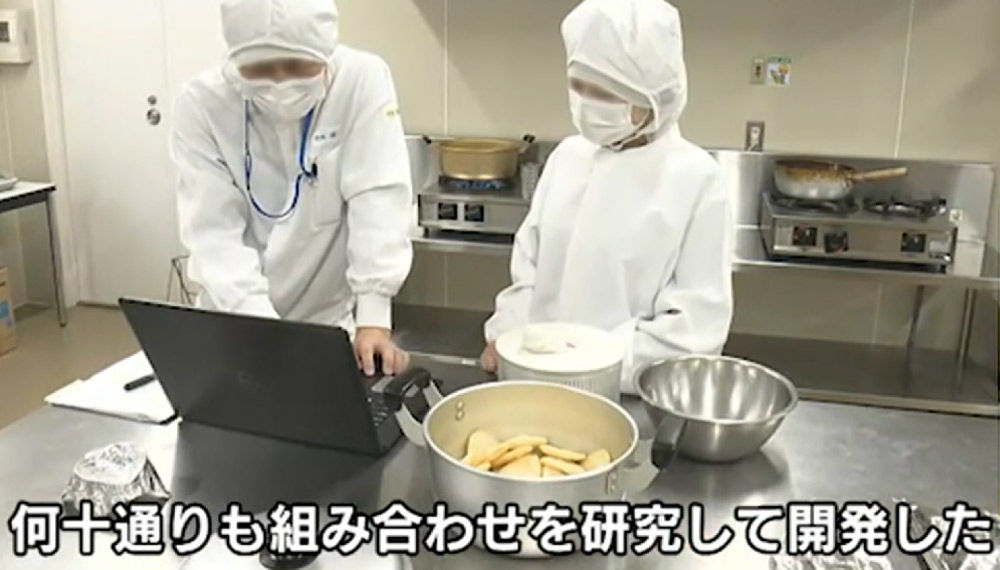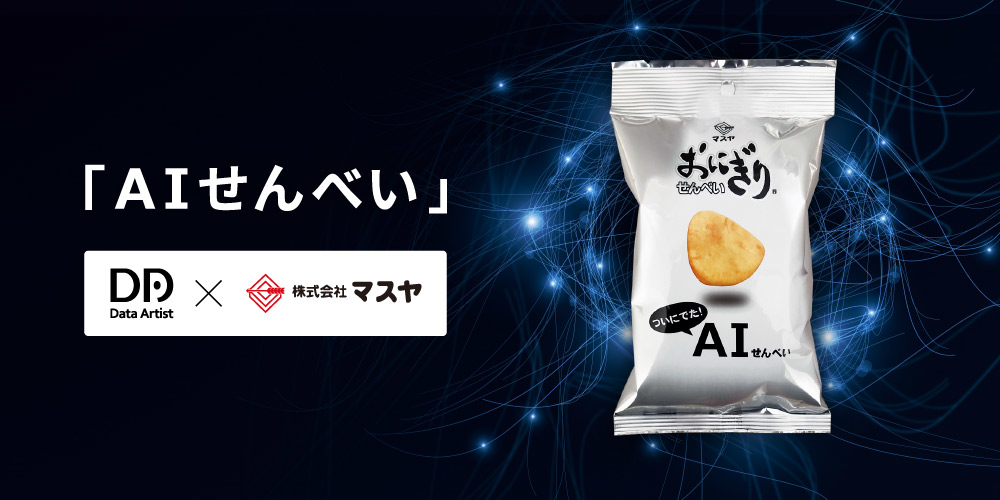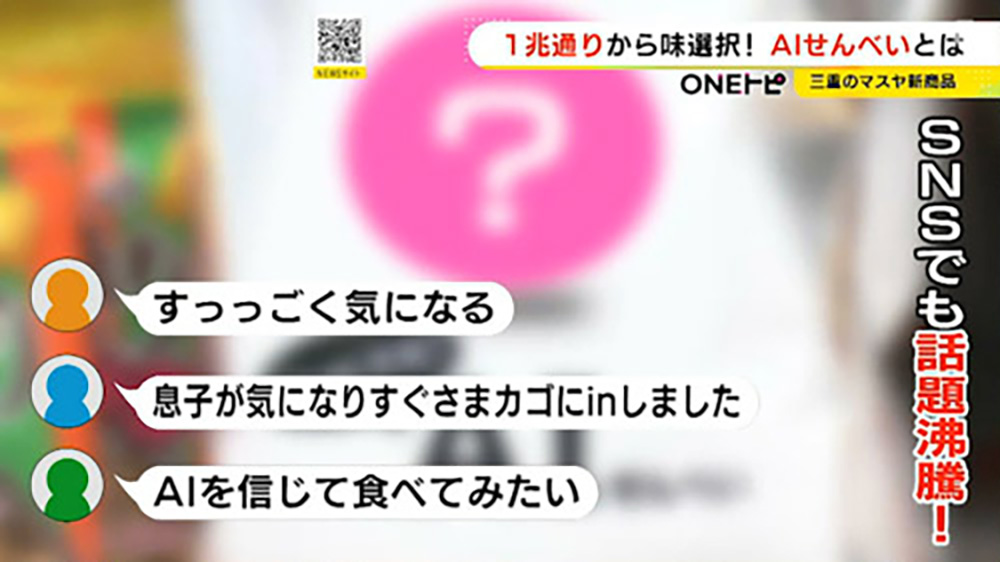In recent years, the application of AI in business has developed rapidly, with more companies challenging previously untapped areas.
The collaboration between Data Artist and Masuya, a long-established confectionery maker in Ise City, Mie Prefecture, is one such example. AI was used to design the flavor profile for a new variant of their long-selling "Onigiri Senbei" rice cracker. Based on the concept of "the ultimate addictive taste," the AI calculated the optimal combination of ingredients. The newly created "Onigiri Senbei AI Senbei" launched nationwide in March 2022 and has generated significant buzz.
Traditionally, AI in product development has mainly focused on generating packaging designs and product names. However, using AI for the actual product development process itself remains relatively rare. What kind of business opportunities and breakthroughs can emerge from combining product development with AI?
We spoke with Mr. Takemasa Kato, Deputy General Manager of Masuya's Sales Division, and Mr. Satoru Yamamoto, CEO of Data Artist, about the project's background and the new possibilities of AI × product development.
AI Drives Breakthroughs in Product Development
――First, could you tell us how this project came about?
Yamamoto: I was appearing on TV Tokyo's business development variety show, "Today's Meeting," and this project originally started as a business collaboration initiative within the program.
Kato: The show asked, "Why don't we try creating new flavors with AI?" I remember feeling excited, even though I didn't really understand it. I had no basis for it, but I thought it might just lead to a breakthrough in product development.
――What challenges did you face in product development at the time?
Kato: Masuya is a long-established manufacturer with over 50 years of history. Our company culture deeply values tradition while never forgetting a spirit of challenge – just like how we pioneered triangular rice crackers when round and square ones dominated the market. However, recently, as consumer preferences have become more fragmented, we faced a dilemma: challenging with bold flavors only appealed to a niche audience, leading to low sales, while flavors that appealed to everyone made it difficult to differentiate ourselves from competitors. We were constantly searching for ways to achieve a breakthrough in product development.
Yamamoto: As part of the Dentsu Group, we had extensive experience supporting creative and marketing efforts around products. But getting involved from the very start of product development and flavor design was new for us, so we thought this would be a really interesting project.
Over 1 trillion simulations revealed the "ultimate" addictive ingredient combination
――How did you arrive at the concept of "the ultimate addictive flavor"?
Yamamoto: Initially, everyone brought in various ideas.
Kato: We proposed things like "a flavor that will be popular 50 years from now" or "a flavor never experienced before." In conventional product development, flavors are conceived based on target preferences and needs. This time, however, we started our thinking from a more playful place – essentially "let's just try using AI" – and prioritized not being constrained by conventional senbei wisdom. At the same time, we needed to ensure it was viable as a business. "Addictive" was a novel idea, yet it captured a crucial element for product development: making people want to eat it repeatedly. We hadn't yet defined exactly what "addictive" meant, but we thought if AI could clarify that, it could be something truly remarkable.

Yamamoto: From our perspective, we had to consider not just the idea's appeal, but also whether it was achievable with AI. When we first heard "a flavor that will be popular 50 years from now," honestly, I wasn't sure what to make of it (laughs). But we determined that creating an "addictive flavor" was feasible.
――Why did you determine that the "ultimate addictive flavor" was achievable?
Yamamoto: Machine learning broadly uses three methods: "classification," "regression," and "clustering." I realized "classification" was exactly what we could use here. Specifically, we could classify recipes in the world into those labeled "addictive" and those not labeled as such. Then, by simulating ingredient combinations used in recipes labeled "addictive," we could derive the optimal solution. After the AI learned the ingredients from 82,000 addictive recipes and simulated their combinations over one trillion times, it identified a combination of seven ingredients—"chicken broth powder, mentsuyu, sesame oil, cabbage, myoga ginger, garlic, and Chinese pickled mustard greens"—that achieved an "addictiveness rating of 99.8%."
――What was your impression when the optimal combination appeared?
Kato: My honest reaction was, "What kind of flavor is this?" (laughs). I could vaguely imagine it being an addictive combination, but I had absolutely no idea what the final flavor should taste like. Plus, ingredients like pickled mustard greens and myoga ginger are rarely used in confectionery manufacturing, so we also had to figure out where to source them.
Yamamoto: The AI itself wasn't doing anything that complex. I think the real trial and error was in the process of commercializing the product based on the optimal combination the AI came up with.
Kato: "Addictive" isn't a specific flavor to begin with, so there's no single right answer. With flavors like curry or mentaiko, you can judge, "This tastes like curry. Mentaiko should be more like this." But what tastes addictive varies from person to person. So the development team made countless prototypes, asked people repeatedly, and ran over 100 simulations.
Yamamoto: I also got to try some prototypes. At the time, they were quite restrained—tasty, but I thought, "This tastes familiar." But the final product was incredibly delicious. You can't pinpoint the flavor, but it's genuinely good.
Kato: Exactly. We aimed for that "What flavor is this?" sensation in the end. For example, letting the noodle broth stand brings out umami components, making it tasty, but if people just said "It tastes like noodle broth," that defeats the purpose. We deliberately worked to tone down the distinct characteristics of the seven ingredients.
――The packaging design is also masterfully ambiguous, leaving you unsure of the flavor.
Kato: Exactly. For snacks or food, it's standard to write "○○ flavor." Because people won't buy something they don't understand. But this time, we challenged that too and didn't list any flavor at all. The packaging design was mainly conceived by a female designer in our company's design department.
Yamamoto: The moment I saw the packaging, I knew it would sell! It has incredible impact and is the kind of design you want to share.
After launch, media coverage flooded in, and it ranked on social media trends.
――How has the response been since launch?
Kato: Thanks to the support of Data Artist for our web marketing efforts, we received coverage from a significant number of media outlets. It also trended as a buzzword on social media for a time. So, in terms of generating buzz, the response has exceeded our expectations.
Yamamoto: While product development using AI inherently has some PR value, I believe the unique aspect of a long-established confectionery maker challenging AI adoption was the key factor in attracting so much media attention. We likely succeeded in effectively guiding user curiosity—like "What on earth does this taste like?"—along with the mysterious feel of the packaging and the desire to share actual taste experiences.
Kato: We were both anxious and curious about whether there would be a difference between the addictiveness level determined by AI and what people actually felt. So, we decided to create channels to gather genuine customer feedback. We printed a QR code on the back of the package to direct people to a survey and solicited taste impressions on social media. We were thrilled when so many people, including many who had never tried our rice cracker before, shared their thoughts.
――Are sales strong?
Kato: We started sales exclusively at convenience stores this time, and we received feedback that the numbers were better than usual. We also sold them at some local supermarkets, where sales were very strong. When we sold them on an e-commerce mall, they ranked #1 in the rice cracker category the very next day. We really feel that many people are interested.
Yamamoto: We've also received inquiries from beverage manufacturers, food manufacturers, and sake brewers.
――Looking back on this project, could you share the benefits of using AI in product development?
Kato: It provides a new development process. Answers derived by AI based on certain evidence feel convincing to everyone, right? Moreover, quantifying and visualizing human emotions like "addictiveness" was something we couldn't really do before. I believe this data-driven flavor development process, where we build flavors based on this data, becomes a new weapon for manufacturers.
Yamamoto: Using AI allows us to not just create and stop, but to continuously improve. Based on consumer survey results, we can adjust the parameters of the seven ingredients to create new versions and gather feedback again. Repeating this process enables ongoing optimization. It would be ideal if we could apply the kind of A/B testing common in the web world to product development. Of course, this approach isn't limited to flavor; it can also be used for optimizing packaging, for example.
Kato: Since our customers span a wide age range, from young children to the elderly, I think we could also optimize for flavors that teens become addicted to.
Yamamoto: Ah, that sounds incredibly interesting. It would be fantastic if we could customize AI rice crackers specifically for people in their 20s or 50s.
Gaining a new development process through AI
――What do you think are the key success factors for AI × product development?
Yamamoto: It's not just about using AI; what's crucial is how interestingly you can conceptualize the technology. I believe this project generated such a strong response precisely because the concept of "addictive flavor" was both unique and catchy.
Kato: That's absolutely right. Beyond that, I think the key point was prominently featuring the "human involvement" as part of the story. It wasn't presented as something solely completed by AI. By expressing the human trial and error leading up to the final product as part of the development story, I believe it gave consumers a greater sense of reassurance. In that sense, combining the strengths of AI with the strengths of humans seems like it could lead to even more interesting possibilities.
Yamamoto: Currently, AI tends to be used more in B2B areas. But this time, thanks to Massya's efforts, we created an opportunity for many consumers to discover the appeal of AI. I'm truly grateful.
Kato: Precisely because we're a long-established manufacturer, we often want to change but struggle to find the right catalyst. Collaborating with companies from different industries, like Data Artist, gives us unprecedented ideas and inspiration, creating opportunities to take new steps forward. I want to keep this momentum going and continue challenging ourselves.












